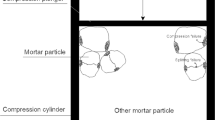Abstract
The determination of mortar load capacity in masonryin situ is not an established technique. An indirect method is described in this paper and, like the earlier one by Gucci, N. and Moretti, A., Boll. Ingegneri Toscana No. 9 (1989), is based on the measurement of the amount of energy required to drill a small cavity in a mortar layer. The instrumentation, designed and built for this purpose, has been the subject of an experimental study aimed at setting up the parameters of measurement and finding the correlation between the drilling work and the mortar compressive strength. The results obtained are reported and discussed, and a first theoretical interpretation is given.
Resume
L'évaluationin situ de la capacité de résistance des mortiers est un aspect de l'étude des ouvrages de maçonnerie qui n'a pas encore trouvé de solution convaincante. Parmi les méthodes indirectes, la technique décrite dans ce travail, qui fait suite au mémoire Gucci, N. et Moretti, A., Boll. Ingegneri Toscana 9, 1989, concerne la mesure de l'énergie dépensée pour l'exécution d'un trou aveugle dans un joint de la maçonnerie. L'appareillage, conçu et construit dans ce but, a fait l'objet d'une étude expérimentale visant à mettre au point des paramètres de mesure et à déterminer la corrélation entre le travail de perforation et la résistance à la compression des mortiers. On rapporte et on discute ici les excellents résultats obtenus, et on en donne une première interprétation théorique.
Similar content being viewed by others
References
Rossi, P. P., ‘Non-destructive evaluation of the mechanical characteristic of masonry structures’ ISMES No. 278 (1990).
Chagneau, F. and Levasseur, M., ‘Contrôle des matériaux de construction par dynamostratigraphie’,Mater. Struct. 22 (1989).
Gucci, N. and Moretti, A. ‘Un dispositivo per misurare in situ la resistenza delle malte’,Boll. Ingegneri Toscana No. 9 (1989).
RILEM, ‘Recommendations for testing concrete by hardness methods’,Mater. Struct. 16 (95) (1983).
Neville, ‘Properties of Concrete’, (Pitman, London, 1975).
Troxell and Davis, ‘Composition and Properties of Concrete’ (New York, 1956).
Gladwell, G. M. L., ‘Contact Problems in the Classical Theory of Elasticity’ (Sijhoff & Noordhoff, 1980).
Micheletti G. F., ‘Tecnologia Meccanica—Taglio dei Metalli’ (UTET, 1976).
Carpinteri and Ingraffea ‘Fracture Mechanics of Concrete’ (Martinus Nijhoff, Amsterdam, 1984).
Page, A. W., ‘An experimental investigation of the biaxial strength of brick masonry’, in Proceedings of the 6th Brick Masonry Conference, 1982.
Atkinson, R. H., ‘Response of masonry bed joints in direct shear’,J. struct. Engng 115 (1989).
Author information
Authors and Affiliations
Rights and permissions
About this article
Cite this article
Gucci, N., Barsotti, R. A non-destructive technique for the determination of mortar load capacityin situ . Materials and Structures 28, 276–283 (1995). https://doi.org/10.1007/BF02473262
Issue Date:
DOI: https://doi.org/10.1007/BF02473262




